
1
VIETNAM ACCADEMY OF SCIENCE AND TECHNOLOGY
GRADUATE UNIVERSITY OF SCIENCE AND TECHNOLOGY
INTITUTE OF PHYSICS
------***------
DO THI HUE
SYNTHESIS AND OPTICAL PROPERTIES OF GOLD
NANOSTRUCTURES SPHERICAL, ROD AND CORE/SHELL
SIO2/Au SHAPE FOR BIOMEDICAL APPLICATIONS
Speciality : Solid State Physics
Code : 944 01 04
THESIS SUMARIZATION
Ha Noi – 2018

2
The work was completed at the Center for Quantum Electronics, Institute of
Physics, Vietnam Academy of Science and Technology
Supervisor:
1. Dr. Nghiem Thi Ha Lien
2. Assoc. Prof. Dr. Tran Hong Nhung
Referee 1: Dr.Nguyen Cao Khang
Referee 2: Prof. Dr Nguyen Nang Dinh
Referee 3: Dr. Nguyen Tran Thuat
The thesis will be presented and defended at the Scientific Committee of
Institute of Physics held in:
.................................................................................................................
at..............................................................................................................
The thesis can be found at the library:
- National Library of Hanoi
- Library of Institute of Physics, VAST

3
1. Origin of thesis title
The gold nano structures are one in the nano physical types used more in
the biomedical applications for increasing sensitivity of the diagnostic and
the targeted therapy. These are the research directions that many labs in the
world and in Viet Nam are interested in developing. Gold nanospheres
show an extinction sccross-section (absorption and scattering) 4-5 orders
higher than conventional absorbing dyes. In particular, the plasmon
resonance of the gold or silver nanostructures can be tuned to specific
wavelengths across the visible and infrared range of the electromagnetic
spectrum, for applications ranging from the construction of photonic
crystals to biophotonics. Moreover, the superior properties of gold
nanostructures are stability structural, non-toxic, highly biocompatible, and
they are easily surface function to bind to biomolecules such as amino
acids, enzymes, DNA and drug molecules through the -SH group. With
these unique surface-chemistry properties, the applied studies of gold
nanostructures are more and more developed and promising great
achievements in biomedical applications. For example: (i) gold
nanoparticles are capable of carring drugs, delivering drugs and
photoluminescence in tissue; (ii) core / shell nanostructures with strong
light scattering from visible to near infrared (NIR) are applied to in vivo
imaging in the body (10 cm) to present cancer cells. At the same time, with
the ability to absorb light intensively in the near-infrared region, gold
nanoshells are used to destroy cancer cells by phototherapy without
compromising healthy cells also do not affect the genetic factors...
Based on the actual exigency and the ability to response those exigencies of
the gold nanostructures, as well as from the research situation in the world
and in Viet Nam, we chose and study the topic: “Synthesis and optical

4
properties of gold nanostructures spherical, rod and core/shell SiO2/Au
shape for biomedical applications”
2. The objectives of research contents of the thesis: (i) to synthesize and
investigate the optical properties of gold nanostructures spherical, rod and
core/shell SiO2/Au shape with controlled sizes; (ii) to try application of
synthesized gold nanostructures in imaging and in photothermal.
3. Usefulness of the thesis:
The thesis is a basic research to orientate application of gold nanostructures
that are and will be promising many applications in nanotechnology,
especially bioapplications. The thesis has found a simple process for
synthesising gold nanoparticles at room temperature by the seeded growth
with particle size be controlled in a wide range from 2nm to over 200nm.
The thesis has controlled minutely the gold film thickness of nanoshells
from 10-30 nm by control of seed concentration. At the same time, the use
of uniform and small size Duff-Baiker gold particles creates a thinner, less
rugged gold film, which is better than today's. Simultaneously, we have
created small nanoshells less than 100 nm with plasmon absorption peaks
about 700 nm.
Thesis structure
The thesis consists of 158 pages arranged into 5 chapters
Chapter 1: OVERVIEW OF RELATED MATTERS AND THEORY
1.1. Optical properties of metallic nanoparticles
1.1.1. Surface plasmon resonance (SPR)

5
Surface plasmon polaritons are electromagnetic excitations propagating at
the interface between a dielectric and a conductor. Metals as Au, Ag and Cu
have plasmon frequencies in the visible light region, so their nanostructures
have color effects. The colour of the colloidal solutions is the result of the
scattering and absorbing of light by the surface plasmon. The optical
properties of metallic nanostructures are explained by the theory of Mie and
Gans.
1.1.2. The Mie theory - the dependence of optical properties on particle
size
From the Mie theory can calculate scattering sca and the absorption cross
section abs of a particle as follows:
2
64
3
512
m
m
sca Rk
+
−
=
abs = 32πkR3Im[𝜀−𝜖𝑚
𝜀+2𝜖𝑚]
Where k is the number of waves, R is the radius of the particle.
The above formulas show that when the particle size is small, the scattering
efficiency is smaller than the absorption efficiency. Absorption A of a
sample of dispersed nanoparticles is given by:
𝐴(𝜆)=𝑙𝑜𝑔𝐼𝜆
0
𝐼𝜆 = 1
2.303𝑁.𝜎𝑒𝑥𝑡
𝜆.𝑙
where ext is the extinction cross section of the sample at wavelength and
N number of particles in a liter, l is the thickness of the absorbing medium
(cm).
1.1.3. Optical characteristics of gold nanostructures

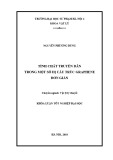


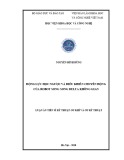

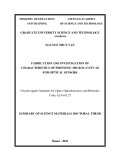
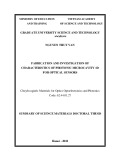
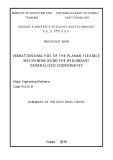
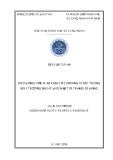
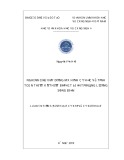
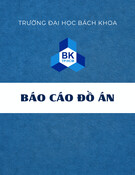
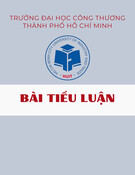
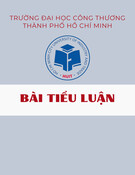
![Ô nhiễm môi trường không khí: Bài tiểu luận [Nổi bật/Chi tiết/Phân tích]](https://cdn.tailieu.vn/images/document/thumbnail/2025/20251011/kimphuong1001/135x160/76241760173495.jpg)

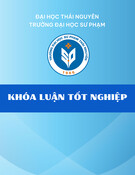





![Ứng dụng kỹ thuật trao đổi ion trong điện phân: Bài tiểu luận [chuẩn nhất]](https://cdn.tailieu.vn/images/document/thumbnail/2025/20250829/sonphamxuan1808/135x160/97341756442892.jpg)



